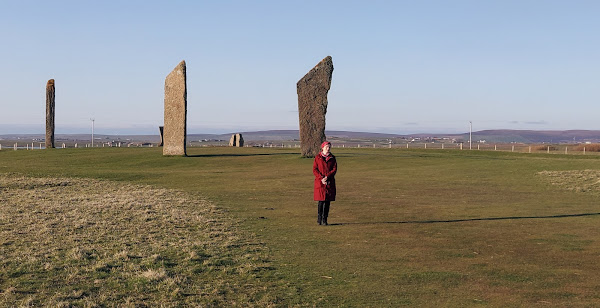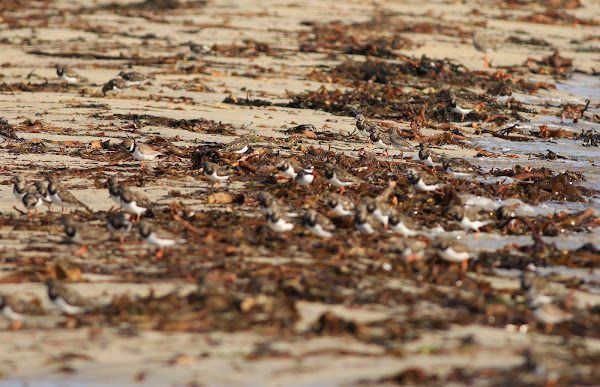Wednesday, April 30, 2025
Orkney - Seaducks, Slavs and Standing Stones
A final post from Orkney, and a selection of photos - of Scaup, Slavonian Grebes and (more) Long-tailed Ducks, and a few of the various incredible neolithic sites we enjoyed.
Oh, and the Grill by the roadside at the Hope.....
Tuesday, April 29, 2025
Orkney - Churchill Barrier #4 (2)
As well as the land-based congregations as featured in the last post, on one particular day the shoreline was enthusiastically attended by a great many gulls - hundreds of Common and Black-headed, with smaller numbers of Herring and Great Black-backed.
Witha natural ringside seat provided by the tide's shaping of the sand and dry seaweed, I spent a very comfortable hour or so in the thick of the action as the gulls feasted on an emergence of invertebrates, unperturbed by my presence.
Monday, April 21, 2025
Orkney, April '25 - Churchill Barrier #4 (1)
Bar-tailed Godwit (above) and Whimbrel (below) - please click on images to enlarge as it seems Blogger is over-compressing them again!
As mentioned in the last post, a beautifully bird-filled beach was just a couple of minutes from our cottage on Burray. Unromantically known as Churchill Barrier #4 - the beach, and its causeway connecting Burray with South Ronaldsay, were created when Churchill ordered the blocking of between-island U-boat access into the Scapa Flow to protect the British Fleet - I spent plenty of time enjoying the birds here during our stay.
Ringed Plover - several pairs on territory were joined by dozens of migrants along the strandline
Relatively undisturbed and blessed with mounds of decaying seaweed and organic marine material and protected from brisk westerly winds (when it was very much at its best), it was a magnet for hungry passerines. Wagtails often numbered around 20, with White (above and below) generally outnumbering Pied, and a maximimum of 14 of the former on my last visit.
Wheatears were likewise ubiquitous, with up to eight feeding a little further up the shoreline:
Waders, meanwhile, were also abundant, with up to fifty Ringed Plovers, 80 Turnstones, 12 Purple Sandpipers, 30 Redshanks, the odd Dunlin, Curlew, Bar-tailed Godwit and Sanderling, and on the last evening, a fresh-in Whimbrel (my first of the year).
Sunday, April 20, 2025
Orkney, April '25 - one
The Gill's Bay - St. Margaret's Hope ferry arriving at the latter on South Ronaldsay

Great Northern Divers were by far the commonest diver, present in most inlets, bays and coves in all states of moult

After a great sixth School of Birding (see last post), I was joined by the Mrs up in the Highlands, where we had a relaxed afternoon down our favourite valley of Strathdearn before heading further north the following day. A rare, non-family, out-and-out holiday, we were excited to be exploring Orkney for the first time.
We're both fascinated by neolithic and ancient cultures and for the sheer variety, quality and complexity of sites, Orkney is unarguably second to none in the British Isles, arguably in Northern and Western Europe, and arguably even throughout the whole of Europe. Yep, it's that exciting and important, and if you've any interest in such things, we recommend you prioritise a visit, pronto....
Plenty of Puffins in Scapa Flow from the ferry
Gannet flying over old military stations
Unfortunately the better half was sick throughout the whole trip, but she soldiered on admirably (as always) and we managed to soak up all the main sites and locations we'd planned on. We also had a very lovely, cosy air BnB on Sanday, which was a great base, as well as an ideal sick bay.
We'd six days and nights on the islands, and drove to Gill's Bay on the north coast (just west of John-o'-Groats) to catch the ferry over to St. Margaret's Hope, on South Ronaldsay - an hour's pleasant journey (proceeded by a decent birding session near the ferry terminal, which included a surprise immature White-tailed Eagle hunting the coastline).
Once docked at The Hope, it was an all of 15 minute drive to our accommodation (via the causeway connecting South Ron and Burray) - although ferries are needed to reach the northern islands, the great thing about most of the southern islands is their connectivity by causeways. For example, a drive to A & E in Kirkwall late on the first night (all was fine, thanks for asking!) took us across four islands - but only took 16 minutes....
Of the islands generally? Birdwise - resolutely not a priority, but an enjoyable side hustle (of course) - pleasantly surprised: it wasn't the time of year to be sniffing around suitable cover for land-based migrants (and there's a lot of cover compared to, say, Shetland), but the landscapes and coastlines held an abundance of visitors and breeders.
On the water, every cove and bay held multiple Great Northern Divers and unavoidable gatherings of Long-tailed Ducks, as well as Red-breasted Mergansers, Eiders, a few Scoters, Goldeneyes, Black Guillemots, auks and other expected fare; Long-tailed Ducks were particularly entertaining, often in the throes of displaying and courting (see later posts).
Hen Harriers - pleasingly ubiquitous, cropping up pretty much anywhere (this one over our accommodation)
Long-tailed Ducks in the bay by our cottage. Be warned - there's more of these to come.....
On the land, it was great to see so many breeding (and passage) waders - particularly Curlews, which were absolutely ubiquitous wherever we wandered, but also Redshanks, Snipe, Oystercatchers and Lapwings.
We'd heard it was good for Hen Harriers and Short-eared Owls, and were not disappointed - we didn't go out of our way to look (for another trip), but had great views of both daily, over and beside the car or while enjoying ancient monuments.
A pair of Common Cranes - conveniently five minutes away when we visited Scara Brae
Conditions were a little suppressive for long-distance arrivals but we did had small numbers of Wheatears, Sand Martins and Willow Warblers; the strandlines, however, were full of passerines, and I enjoyed the unromantically-named Churchill Barrier #4 (two minutes from the cottage) on various occasions.
The food-filled banks of seaweed attracted excellent numbers of pipits and wagtails, with e.g. a maximum of 14 White Wagtails on one occasion (and lots more besides) - if there hasn't been mega-rare Anthus or Motacilla here, I'll swim back to the mainland next time....

Great Northern Divers were by far the commonest diver, present in most inlets, bays and coves in all states of moult
Freshwater lochs likewise held plenty of interest, with Echna loch (again just a few minutes away) hosting dabbling and diving ducks, and plenty of Long-tailed Ducks commuting over the road from the bay.

The latter species was even more approachable at the slightly surreal location of the Peedie Sea, which is basically a boating lake bang in the middle of Kirkwall - surrounded by busy roads, shops and people - where they were happy to carry on as if they were in a far-flung corner of the Baltic....
(Plenty more to follow!)
Subscribe to:
Posts (Atom)




















































